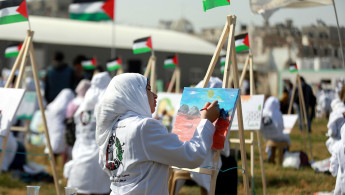Remembering Land Day
How far-fetched this day seems. Land Day, 30 March, is an annual day of commemoration for Palestinians of events that took place on that day in 1976. However, the day has sadly turned into a memory and lost its power as an occasion to confront and challenge Israel.
Nothing remains for the Palestinians except the memory of them trying to unite the land and people on many occasions.
Land Day marks the day when Zionist occupation forces occupied 12 Palestinian villages and cities in Galilee on 30 March 1976. In 1959, a movement calling itself "The Land Movement" held its first meeting. The movement shed light on the meaning and objectives of the Palestinian resistance since Zionist occupiers landed on Palestinian coasts.
Members of this movement issued journals under names promoting these notions and objectives: the land, the good land or the scent of the land. But activists in the movement were later arrested, and its cultural and sports centres were shut down after its popularity rose and it started speaking for Palestinians as a whole and uttering the truth.
Raising awareness
The movement has raised awareness of the true meaning and objectives of the Palestinian resistance, as opposed to the core of the Zionist colonial movement based on confiscating land and ending the Palestinian presence there. The Zionist movement has not stopped since the Palestinians of the coast were uprooted and dozens of villages were destroyed, while other cities like Acre, Jaffa, Haifa and Jerusalem were looted. The Zionist occupation continues to confiscate houses and lands in Acre, al-Lad, al-Ramlah, al-Naqab and Jerusalem.
| The Zionist occupation continues to confiscate houses and lands. |
On Land Day, before the Palestinians whose lands were confiscated in Galilee and elsewhere in Palestine, who were turned from landlords into strangers and displaced in their homeland, rose up, the governor of Galilee Yisrael Kaneg was examining what he called the dangerous phenomena posing a threat to his so-called settlement Israel.
Kaneg studied the phenomenon of the growing patriotism of Palestinians after 1967 and 1973 and their increasing numbers especially in the Galilee where they represented 67 percent of the overall population. He also observed their penchant for education and their repudiation of the occupation and its myths. He was concerned about their determination to maintain their land and face down colonial forces. He also looked at the population concentration of Palestinians which made the projects of building settlements to attract Zionists to Galilee useless.
Yisrael's observations are remarkable for two reasons. First, he was alarmed the Palestinian majority in the north could pave the way for the infiltration of Palestinians from the north. Second, he was concerned this Palestinian majority would call for a referendum over the future of Galilee. Of course, his concerns are valid because according to UN resolutions, the upper Palestinian Galilee is occupied lands usurped by the Zionists.
In a secret report Yisrael submitted to his interior minister on 1 March 1976 he called for lands to be confiscated, for Palestinian communities to be disperced and for their access to education to be limited so they would be pushed to emigrate and pursue education abroad. He also suggested that financial aid then offered to families with over two children be limited to Jewish families.
He proposed that the Palestinian workforce in factories should not exceed 20 percent, and called for other measures ultimately aimed at Judaizing Palestinian Galilee. As Yisrael expected, the Land Day intifada broke out on 30 March 1976 a month after he submitted his report. The Palestinians rose up after receiving information about the Zionists' intentions to confiscate more land.
More lessons learnt
The Palestinians had to stand up against Zionist intentions and measures, and they called for a general strike and demonstrations. These took place in many villages such as Sakhneen, Arabah, Kafr Kina and Deir Hanna. Palestinian farmers did not fear colonial forces and faced them with all means within reach. Many martyrs fell and the confrontation only ended when occupation forces recanted their decision to confiscate the lands.
Yisrael was a close observer and drew lessons from the intifada. He was surprised by the comprehensive and successful strike and how all attempts to disrupt it failed. He analysed the reasons behind the success and attempted to draw up plans to face it. He also highlighted the feeling of power and self confidence the Palestinians acquired as a result of their confrontation with the occupation army. He voiced concerns to his authorities that these feelings could be strengthened by strong leaders who would be able to mobilise the Palestinian populations to further face the Zionist settlers.
Yisrael did not forget to remind his authorities that: "For the first time since the rise of Israel, the Arab population opposes the government and express willingness to carry out an action to achieve their demands."
More seriously, in his opinion, was that: "a large part of the Arab population defended and continues to defend those who attacked the Israeli army and overtly say they are part of it."
This article is an edited translation from our Arabic edition.
Opinions expressed in this article remain those of the author and do not necessarily reflect those of al-Araby al-Jadeed, its editorial board or staff.



